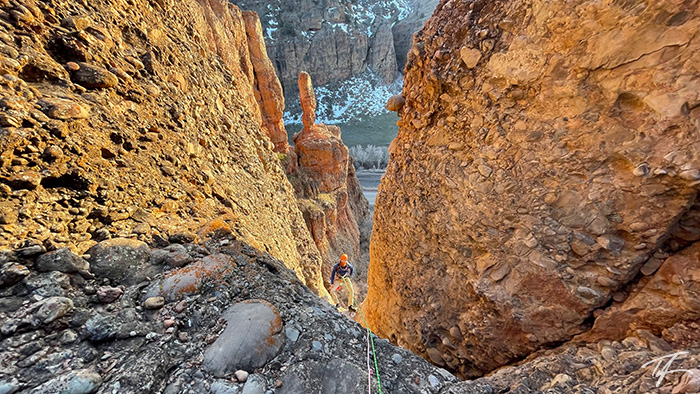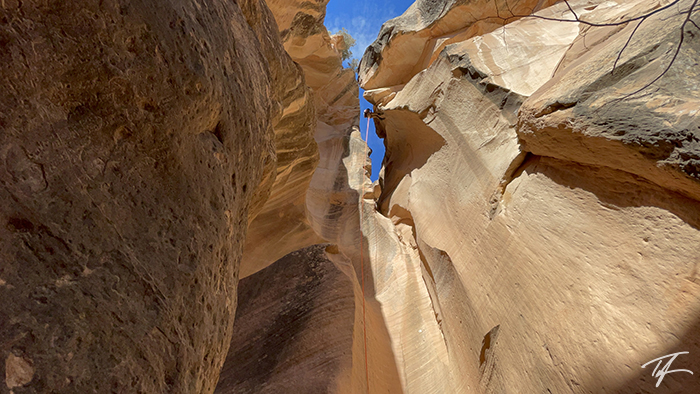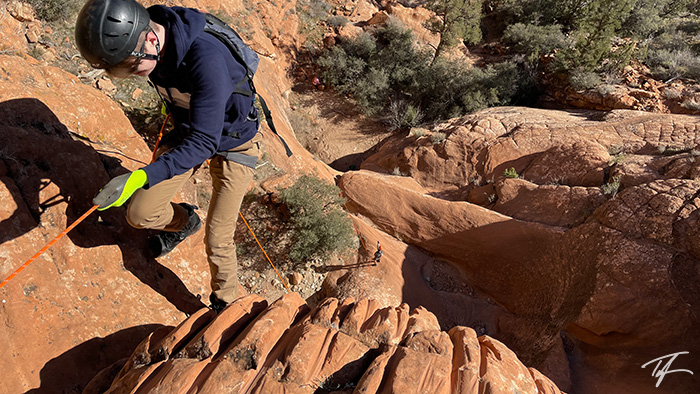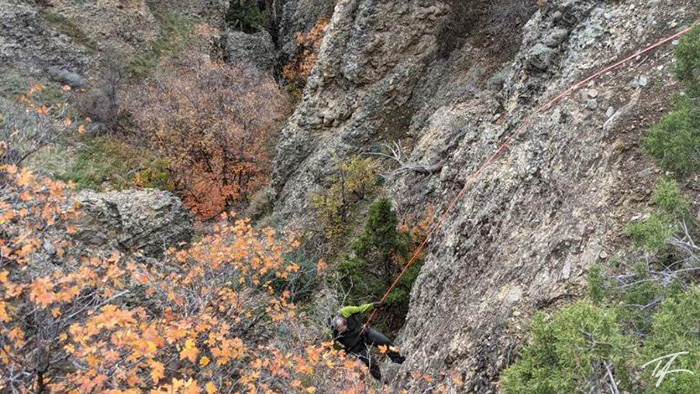Canyoneering
Canyoneering
Merriam-Webster says the term "canyoneering" was first used in 1957.
Canyon... er... WHAT!?! Americans call it "canyoneering." The international community calls it "canyoning." Both mean the same thing. Generally, it is the exploration of a canyon. Simple. Right? Not so fast. We're not talking about just driving up a canyon, or hiking between two mountains. Canyoneering is often a very technical and skill-demanding experience.
Canyoneering definitely requires hiking—often a lot of it—especially when approaching or exiting a canyon to and from a trailhead. But once you get to a canyon, a technical canyon will require you to gear up with climbing harnesses, helmets, a rappel device, ropes, and more. As you progress through these canyons, they often have narrow passages called "slots." They also will randomly drop anywhere from several feet—where you can "downclimb"—to well more than a hundred feet. Those drops are where you need the specialized technical gear of a harness, ropes, and more. Canyons often require everyone to rely on each other for "partner assists" to get through the more difficult obstacles. Canyons can have "constrictions" in them where the walls are so close together that you can't fit through and have to use your body and friction to "stem" where it's wider above the tight spots until it widens out enough to "chimney" down to the canyon floor. You might even have to build safe anchors to rappel off—preferably using natural objects or "ghosting" techniques.
If the canyon has any water in it, you might need a wetsuit—even on the hottest days of summer. "Why would you need a wetsuit on a 100º+ day?" A canyon might have a stream or river running through it. Or, it might be a usually dry drainage that has "potholes" in it holding water deep enough to swim in long after the latest rain. These potholes are in canyons that aren't much wider than six feet between the walls—if that. With these narrow, often sandstone canyons, those potholes don't see much sun and the water stays bitterly cold.
"How many of these canyons exist?" Hundreds, if not thousands—with a very large concentration of them in the desert Southwest. I'm lucky enough to live about a half-day drive from most of those. A lot of them can be completed in under three hours. Most are a solid half to a full day. And a small handful require more than one day to complete. Nearly all of them have zero cell phone service and very limited GPS reception—due to the fact you are usually deep in a narrow crack surrounded by solid rock walls. This is where your experience, training, and emergency preparation come in.
Mistakes while canyoneering can and often does result in serious injury and even death. Falling. Dehydration. Hypothermia. Heatstroke. Heat exhaustion. Flash floods. Drowning. And even something called "suspension syndrome." You must know, understand, and respect the power, challenges, and risks of every canyon you enter. Once you pull your first ropes, you are fully committed to that route, even if you read your maps wrong. Forget Canyoneering 101—you might find yourself in Troubleshooting 692. Either way, canyons will teach you plenty of lessons. Don't go into the final exam unprepared.
Even a repeat run years later through the same canyon can be an entirely different experience.
I beg you to
- never go alone
- always tell others where you are going and when to expect you back
- get proper training, do extensive research, and practice for the route and emergency scenarios
- only go in the canyons you have the abilities to overcome the challenges and minimize risks
- be smart enough to know when it's not safe to enter and humble enough to act on that
- watch out for each other—continuously monitoring everyone's setup and health
- harness, carabiner locked, correct and safe knots, shivering, confusion, etc.
- keep calm, cool, and collected—relying on your training when something goes wrong.
- make sure everyone has the knowledge, skills, and gear to safely perform rescues if needed
- stop, find a safe place, don't continue, and wait until danger passes or rescue arrives—if lives are in danger.
If this sounds exciting to you, then we are kindred spirits. So, be safe out there. Who knows, maybe we'll see each other on one of these routes.
Canyoneering is an inherently dangerous activity and can cause serious bodily injury and possibly death. Terrain, weather, and other conditions are constantly changing. Therefore the content provided on this website may or may not be reliable if you choose to use it for a trip. You are solely responsible for your own safety and well-being. The purpose of the content in the Canyoneering section of this website is for the owner's own reference and not intended as a reference guide for others. The owner of this website cannot be held responsible or liable in any way for any damage to property and/or person. By viewing this website, you affirm that you understand this disclaimer and that you knowingly and voluntarily agree not to bring any type of claim arising out of or related to the content herein.




